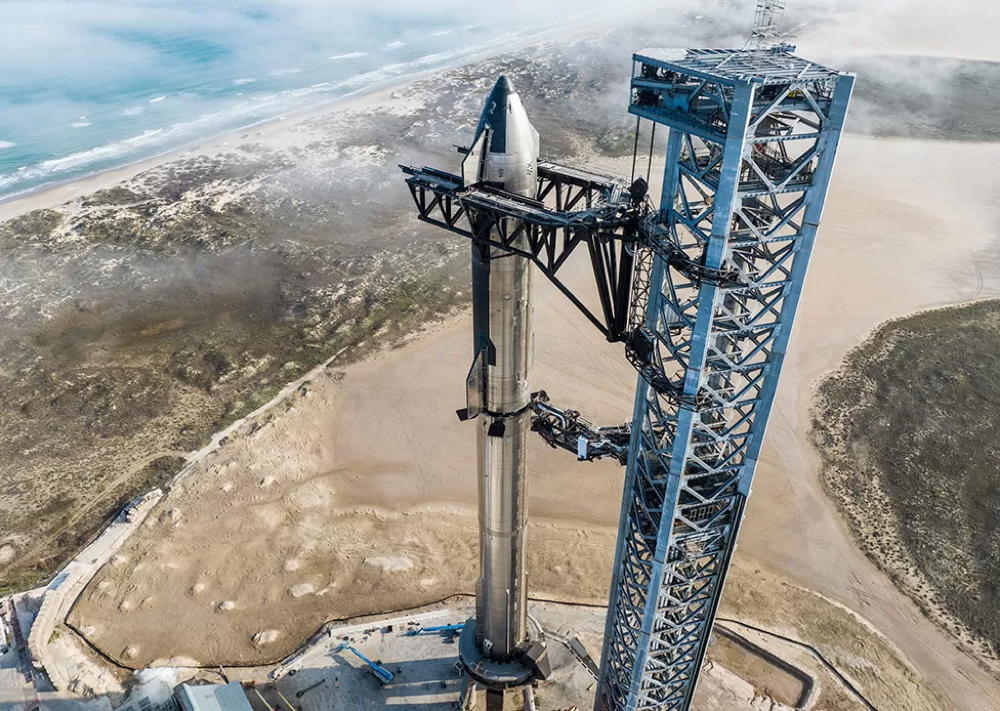

Starship rocket on launch pad. Image credit: SpaceX.
The launch of the world’s largest rocket ended suddenly on Thursday, after SpaceX’s Starship rocket exploded mid-flight, minutes after blast off.
On Thursday SpaceX’s uncrewed Starship spacecraft, which is intended to carry astronauts to the lunar surface for NASA and eventually to Mars, sat atop the powerful Super Heavy rocket as it was launched into space.
The SpaceX rocket flew for four minutes to a maximum altitude of 39 kilometers, or about 127,000 feet, before exploding. That distance is short of the 100 kilometres mark that is internationally-recognized as the boundary of space.
It comes after SpaceX had delayed Monday’s planned launch of the world’s most powerful rocket ever, just 40 seconds before lift off.
That delay came after SpaceX identified a problem with a frozen pressurant valve.
The launch had received approval from regulators last week, after SpaceX had been left waiting for more than a year.
The Starship vehicle, together with its first-stage booster called Super Heavy, is designed to deliver a total of 72 meganewtons of thrust, nearly twice that of NASA’s Space Launch System, which at 39.1 meganewtons is currently the most powerful rocket that has ever flown.
SpaceX has held a number of short-range prototype tests from its Boca Chica launch pad over the past few years, with a number of them ending in dramatic explosions as the vessel settled vertically back onto the launch pad.
The company carried out a successful suborbital test in May 2021 and since then has been working to get the Super Heavy booster ready for flight, with its 33 Raptor engines.
Together Super Heavy and Starship are nearly 120 m (400 ft), taller than NASA’s Saturn V that carried out nine crewed missions to the Moon in the late 1960s and early 1970s.
The Starship launch was designed to see Super Heavy lift Starship off the ground at 90 percent of its maximum thrust, before making a partially controlled descent and sinking into the Gulf of Mexico.
Starship was then intended to complete a transit almost all the way around the globe using its own rockets, then return through the atmosphere and drop into the Pacific Ocean near Hawaii about 90 minutes after liftoff.
And on Thursday SpaceX launched its Starship rocket for the first time, but it fell short of reaching space after the Super Heavy rocket exploded in mid-flight, after the Super Heavy rocket failed to separate from the Starship.
No crew were on board.
A video of the launch can be found here (skip forward to 45 minute mark for actual launch).
After the explosion, SpaceX issued a very droll tweet, labelling the explosion as a “rapid unscheduled disassembly”.
“With a test like this, success comes from what we learn, and today’s test will help us improve Starship’s reliability as SpaceX seeks to make life multi-planetary,” added SpaceX. “Teams will continue to review data and work toward our next flight test.”
Elon Musk congratulated the SpaceX team and said the test launch of Starship will provide valuable insight for the next launch in a few months.
Chinese rival BYD overtakes global revenues of Elon Musk's Tesla, as record number of Tesla…
Messaging app Signal in the headlines after a journalist was invited to a top secret…
OpenAI chief operating officer Brad Lightcap to oversee international expansion as company consolidates lead in…
Chinese researchers publish details on device that could wreak havoc on undersea communications cables in…
Former Intel chief Gelsinger expands role at Gloo, becoming executive chairman and head of technology…
MEPs add to Commission pressure for second EU Chips Act amidst industry calls for renewed…